Reviews: March 2013
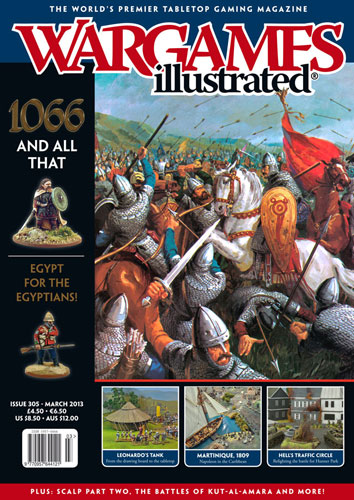 |
Reviews:
March 2013
Our regular, monthly round-up of what's new on the hobby scene.
Enjoy!
|
28mm American Civil War Confederate Infantry 1861 - 1865
Perry Miniatures
http://www.perry-miniatures.com
Reviewed by Wayne Bollands
When the first boxes of Perry Miniatures ACW plastics came out, I bought quite a few to add ‘bulk’ to the metal units I already owned. I liked the fact that I could add items from the box, undertake simple conversions and add extras from my supply of accumulated ‘bits’ to create fairly unique figures. So, as a fan of past releases, it is refreshing to find a new box set that is specifically aimed at the Confederacy.
The range of options in this set of 44 figures provides the gamer with the ability to field ‘smart’, kepi wearing units or more varied headgear in the shape of a range of soft hats. Indeed, for the full effect of a more traditional, ‘ragged rebel’ look, one can mix the two styles of headwear. The main figures are all wearing short jackets and are festooned with blanket rolls, cartridge boxes, water bottles and musette bags. They have the appearance of experienced troops as a result. The poses are far less static than the original infantry box sets, with each figure leaning slightly forward from the small base to which they are attached.
|
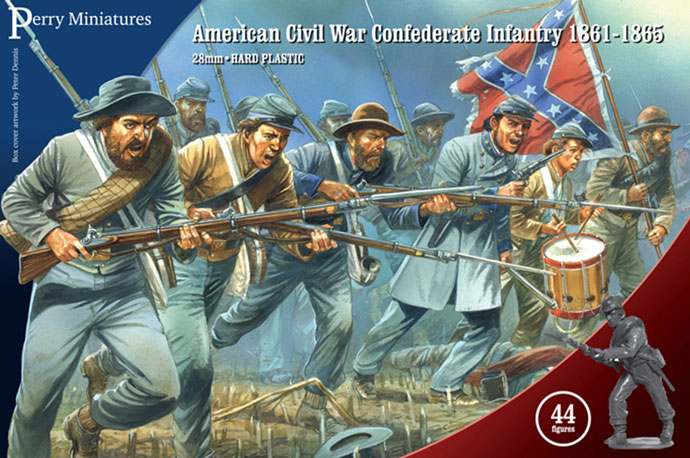 |
This sense of forward momentum is designed to work with the arm options included on the sprue. The figures can be modelled with either musket at right shoulder shift, as if hurrying to battle from the reserve, or at the charge, no doubt shouting a ‘Rebel Yell’ to unnerve their opponents. For me, this means that my Confederate force can now benefit from figures of the same scale but with the well-sculpted dynamism to provide a more aggressive aspect, moving forward to take the fight to the enemy whilst their fellows lay down some supporting fire.
In addition to the privates included in the box, there are two command sprues, both of which consist of an officer and other ranks figure. Even here, there are optional extras. The officer may be modelled with revolver in hand, clutching the scabbard of his sword as he advances. The second figure on the sprue could be turned into a drummer, standard bearer or carrying a musket at the trail. Of course, this means that one can create two different styles of command stand or one complete set of all four possible command combinations. Equally, gamers could create ‘unique’ command groups, with officers clutching the standard or perhaps armed with muskets to avoid standing out on the battlefield, etc.
|
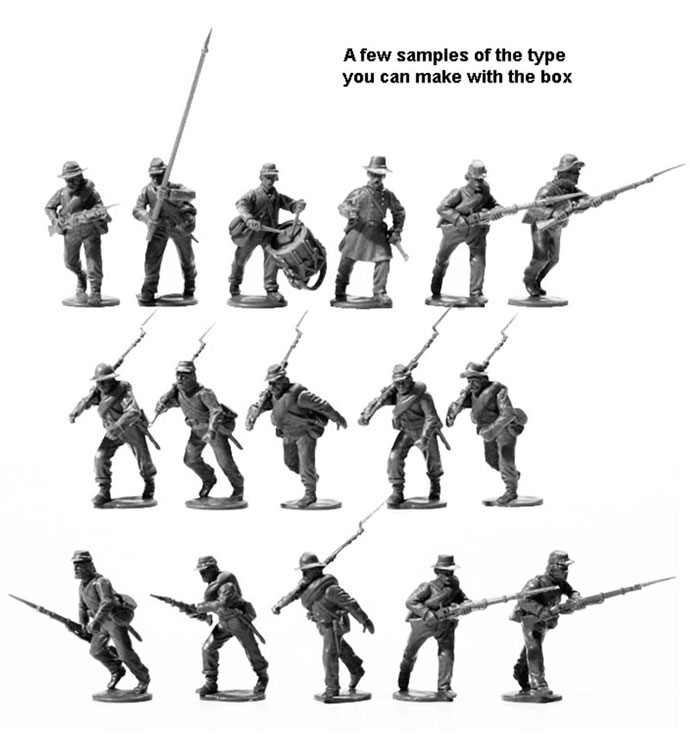 |
The issue of command stands and basing units is, as expected from the Perry’s, solved by the fact that the box contains enough unit bases to create blocks of between three and four figures in the desired mix of poses. Also included in the box is a lightweight, colour printed (and slightly glossy) card insert, that provides details of some of the units in the Confederate States Army, thereby serving as an obvious painting guide. This insert also provides eight alternative ‘cut out and stick’ flags from the period.
All in all, this is a worthwhile addition to the range of plastic ACW miniatures available from the Perry Miniatures range. The level of research and sculpting which has gone into this boxed set is to be applauded. Equally, the fact that the Perry’s have once again included the sort of ‘extras’ which the average gamer may like, such as optional headgear, fairly customisable figures, bases and a painting guide continues to demonstrate why the ‘Perry Plastic Way’ is still the standard others emulate but never quite surpass.
|
28mm Eastern European Buildings
1st Corps
http://www.1stcorps.co.uk
Reviewed by Wayne Bollands
First of all, many thanks to 1st Corps for providing one of their new resin buildings and optional ‘extras’ for review. I am in no way an expert on historical buildings but it is always interesting to see the inherent ‘gaming factor’ that certain companies consider before adding an item to their ranges. In this case, the fact that these new buildings can be considered to have an element of ‘modular design’ allows the purchaser to create a series of fairly customizable buildings. You can conceivably imagine a village or hamlet of similar but slightly varied buildings, found throughout history and certainly in Russia for many hundreds of years.
In essence, the range consists of a large log cabin base, a choice of shingle or thatched roofs and extras including a storehouse, porch and a toilet. An additional option but not provided to this reviewer is a well. The buildings are provided in the form of bundle deals with the code EE/Build/01 to 05.
|
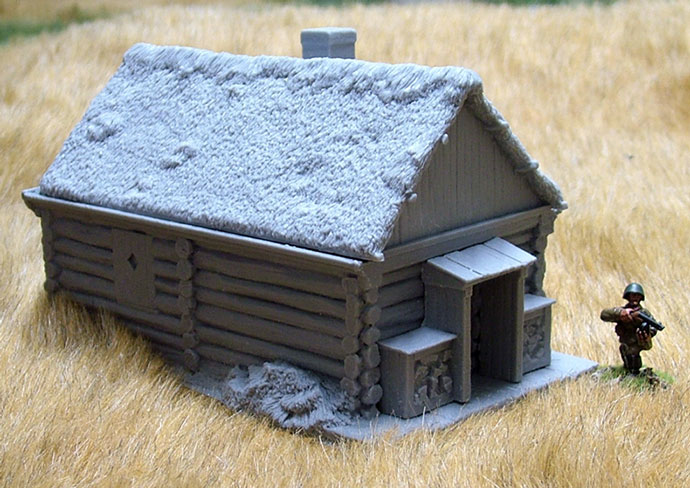 |
The log cabin base consists of a one-room structure with clearly defined internal and external features. The logs, windows and window shutters sculpted on the outside are well executed. The diamond shapes sculpted within the shutters are particularly evocative of a rural setting. There is an area of wooden planking just outside the single door to prevent the 28mm occupant traipsing spring thaw mud into his residence. The porch available in some packs fits around this doorway to produce an area to smoke a pipe, sheltered from rain and snow. Firewood storage bins, a nice touch, flank this porch area. The interior also has some detail, with a continuation of the wooden flooring and a plain but functional looking fireplace beneath a chimneybreast. Figures can be easily placed inside, although the windows and single door are sculpted closed.
The cabin has a choice of roof, again depending on the deal purchased. The wooden or tile shingle roof has a rough hewn, worn quality suggesting regular repair or the liberal usage of vodka by the East European equivalent of Barratt Homes. This is a pleasing feature of the sculptor’s work, the end result being more realistic as a result. The thatched version of the roof is equally well done, being not entirely ‘perfect’ and possibly in need of repair prior to the next winter. Each roof comes with a chimney, in different styles but both solid looking.
|
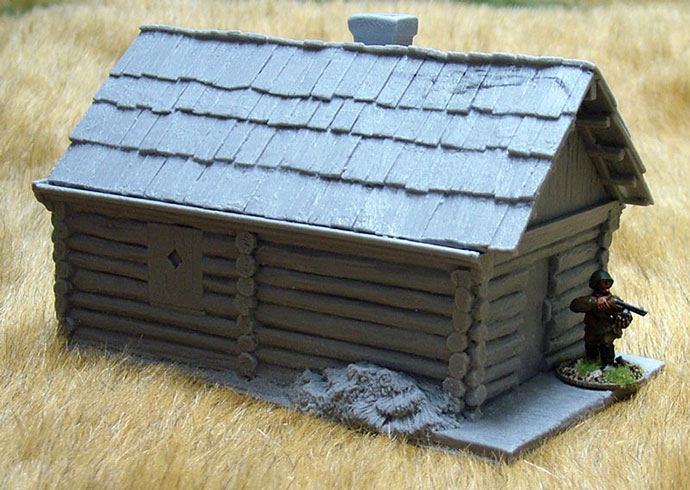 |
No desirable rural residence should be considered complete without certain outbuildings and this option is provided in the form of a set consisting of a well, store house and toilet. As already stated, the well was not provided for review but the storeroom and toilet continue the theme of hand made quality typical of the buildings once found in Eastern Europe. The storeroom has some qualities akin to the shingle roof but has no base, obviously being designed to rest on the floor. The toilet is the typical ‘outhouse’ once seen on every continent and probably still in use in a number of places.
Cast in seemingly robust resin and a solid, quite appropriately ‘chunky’ style, these buildings seem suitable for a range of periods within the Eastern European area. In fact, as emigration from the diverse regions took place quite often, the style may also be found in other parts of the world, perhaps making these buildings suitable for a range of gaming options. The deals available also provide the gamer with the chance to make a suitably Slavic-looking community. In essence, 1st Corps are offering single buildings at a reasonable price with enough options to please anyone looking for well-sculpted examples for use on the tabletop.
|
The Chief: Douglas Haig and the British Army
by Gary Sheffield
Aurum Press 2012
www.aurumpress.co.uk
Reviewed by Jim Graham
The Chief is 462 pages long with 8 pages of black and white photos; extensive endnotes and has a remarkably extensive bibliography.
Gary Sheffield’s place among Great War historians is well known, having published a number of books and taught at King's College, Sandhurst and the army Staff College. He is very much of the revisionist wing of Great War historians and his work consistently strives to re-evaluate the evidence and to put forward the proposition that Haig et al were not simply “butchers and bunglers”. He has his work cut out with this subject.
|
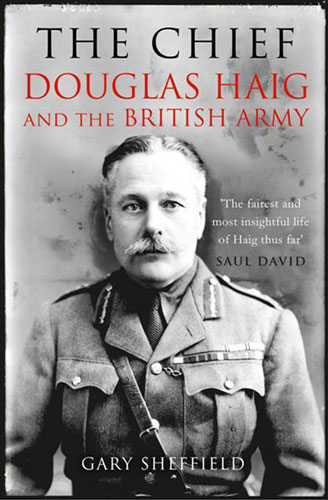 |
Field Marshall, The Earl Haig still a divisive
figure in British history, the popular view remains that of a "donkey",
to use Alan Clarke's invented phrase, but there is a growing body of
opinion that despite his mistakes, and there were plenty of those, Haig
did a good job both compared with his colleagues and with his peers in
other armies.
The book covers Haig's life prior to the Great War but only to set the scene, showing him as a reliable and well liked regimental officer and as a hard working staff officer in the South African War. The bulk of the book covers Haig’s actions in the Great War, beginning as a corps commander, quickly rising to army commander before becoming BEF commander in late 1915. Sheffield covers this period in detail, making use of Haig’s diaries, comparing them with unit histories and the diaries of others, to show how his subject thought and what his views actually were. The author takes the various popular beliefs about Haig and shows that these are largely untrue or completely invented. As Sheffield points out, Haig was unfortunate to die before Lloyd George whose memoirs firmly place the blame for everything on Haig, conveniently ignoring his own culpability as one of the politicians who agreed to it all.
Sheffield also highlights the problems of being a "contingent commander" in a coalition, particularly as the junior partner who was under pressure from the politicians to support the French attacks, but to do so without incurring heavy casualties. As such many of the battles Haig is criticised for fighting were forced on him especially in 1918 after the appointment of Foch as Generalissimo. Despite this, this is not an uncritical defence of Haig, the author points out what he thinks were Haig’s failings and where he thinks Haig should have done better.
The book’s major failing is that it reads like something Professor Sheffield felt obliged to do, a term paper rather than a labour of love. Having written so extensively on the war it is as if he has needed to “complete the set” as it were. There is sometimes the feeling that he is analysing and defending Haig out of a sense of duty rather than belief.
This is an interesting book for the historian but I am not sure what the average wargamer would get out of it. Those with an interest in the period will at the very least find themselves better informed and better able to decide for themselves whether Haig was a hidebound Victorian cavalryman, a visionary or something in between.
|
|
|